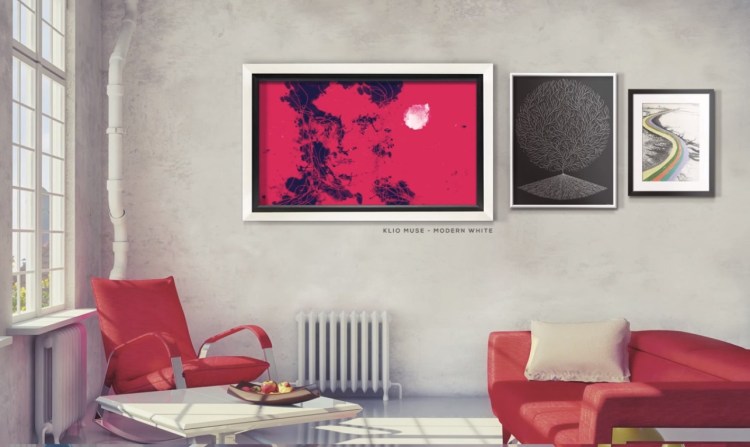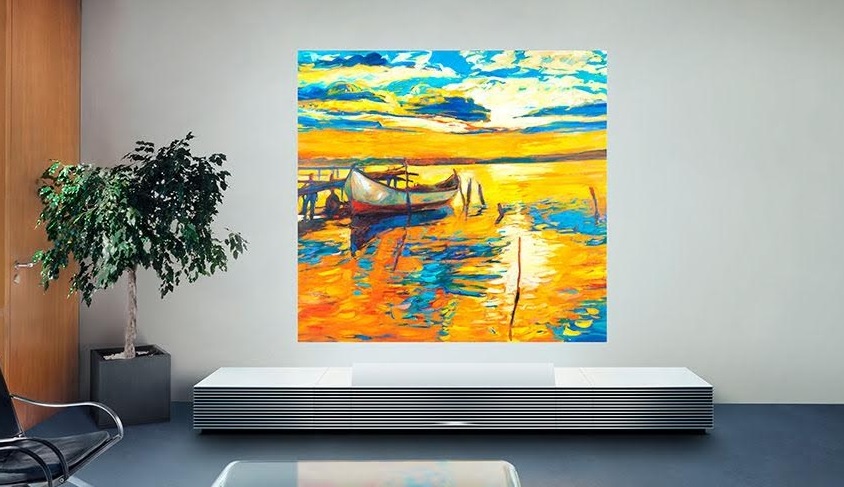Last year a DIY project went viral. Its creator, Clay Bavor, who also happens to lead VR at Google, used a 5K iMac and a host of lighting tricks to simulate a painting. House guests couldn’t tell that the paint strokes were pixels.
I wanted one but didn’t want to cut a hole into the wall and shove a computer inside, so I began Googling for something I could buy. This search led me down a rabbit hole of Skype conversations, loaner units, and in-person demos. I emerged impressed by the digital art frame landscape, excited by the future, and a tad worried about the cultural ramifications.
The current landscape: Mimicry vs. motion
There is no shortage of Kickstarted and venture-funded companies trying to reinvent the art that hangs on your walls. And you can plot them all on a simple spectrum. Some companies are focused on replicating the experience of framed ink (“mimicry”); others are focused on delivering made-for-digital pieces (“motion”). These two approaches are best embodied by two products, the Meural and the KLIO.
The Meural is the Kindle of the digital art frame world. Its co-creator, Vladimir Vukicevic, joked that one of their marketing problems is that if someone stumbles upon the Meural in the wild, they might think it’s an actual Van Gogh instead of an electronic device. Aiding the Meural’s illusion are three tricks: a proprietary chemical coating that absorbs light, ambient sensors that adjust luminosity, and a team of art experts that manually calibrates every piece.
The Meural’s marquise effect is stunning, though it varies from work to work. Paintings look tactile, modern works pop out, and photographs are somewhere in between. The Meural has animations too, but that’s a secondary interest.
At the other end of the spectrum stands the KLIO. Even with its 4K resolution, you’d never confuse a still work on the KLIO as being anything but digital. The KLIO sells you on a library of made-for-digital art, like what you’d find at a modern museum installation.
I talked to Paul Golding, the inventor of the KLIO. Part scientist, part inventor, and part philosopher, Golding is obsessed with pushing the digital medium to its breaking point. His team, part of Art.com‘s R&D lab, spends as much time commissioning and collaborating with cutting-edge artists as it does on the hardware itself.
Beyond the obligatory art that loops, the KLIO has art that unfolds over time, either moment to moment, like an abstracted clock, or over the course of an entire year. It has art that’s built on public data and art that’s algorithmic, with many more new categories in the works. Much of it is stunning.
Both approaches to digital art, mimicry and motion, will have their fans. And convergence might eventually come. In the meantime, we have a more pressing, existential question to answer: Do the benefits of digital art for the mainstream outweigh their installation, cost, and dangling power cable?
Are digital art frames worth it?
Digital art frames are haunted by the specter of digital photo frames. If you ever meet someone in the space and want to see their jaw clench, draw the comparison. Thankfully, the factors that led to the failure of digital photo frames are generally absent from digital art frames.
Digital photo frames failed because no one wanted another corded device on their desk and because special photos are meant to be printed and not commoditized with a thousand others (that’s what your phone is for!). In contrast, anyone can find wall space for a digital art frame and art is something everyone wishes they could enjoy more of.
Digital art frames add value in other ways too, through education and personalization.
Education. You can cycle through an artist’s portfolio, perhaps from their earliest works to latest, and see how their style evolved. You can view art from certain geographies, so you can learn more about the Berlin and LA art scene. You can view art from certain movements and eras. Or you can keep up-to-date on what’s currently in vogue, curated by people with better taste than you.
Personalization. Digital art frames can help you better decorate your space. Instead of taking a leap of faith at a gallery and hoping that a piece looks good in your bedroom, you can test out pieces on-the-fly. And you can discover new works that fit your preferences or mood.
Digital art frames are here to stay. Their value is simply too compelling. So now that we’ve validated the present, let’s look to the future.
Where are things going?
Let’s get the obvious question out of the way. Unless there’s a massive breakthrough in color e-ink, we won’t get a cordless digital art frame anytime soon. So we’re stuck with power cables or calling an electrician. Moving on.
We’ll have less fragmentation for digital art. The current landscape is filled with exclusive pieces. If you love the Meural’s form factor but prefer the KLIO’s content, you’re out of luck. In the future, I see digital art evolving like digital music. The vast majority of works will be available on all platforms.
We’ll have artists who’ve become famous through digital art frames. Artists who can do spectacular works in digital or who hitch their wagon to the right platform will gain an instant audience. Everyone in art school and beyond needs to be paying attention to this space.
We’ll have Internet of Things integrations, so you can command your art with your voice or have your lightbulb hues synchronize with a piece.
We’ll have art frames with cameras that enable parallax movements and frames that can save wall space by being able to transform into a mirror.
We’ll have lots of form factors. Today, all the digital art frames are rectangles because that’s the most widely available type of screen. This is a problem because most art isn’t 16:9. Eventually, squares and circles will proliferate.
We’ll be able to synch multiple frames together to display extra-large works or synchronize animation.
And then perhaps the idea of a digital art frame will vanish altogether.
Sony is investing big in projector systems. Its Ultra Short Throw Projectors can light up your entire wall while resting discretely at your wall’s base. If these projector systems get better and smaller, they could replace everything that hangs on your wall in one go.
Beyond that there’s AR. If we’re walking around with AR glasses all the time, then our headsets can project 3D decorations on empty walls. One difficulty with digital art is that even with perfectly mimicked paint strokes, they’ll still be flat. AR paint strokes will be 3D.
3 things I worry about
So far I’ve described a rosy future for digital art frames. But I’m also a bit nervous about their ramifications.
The pioneers behind digital art frames, like Vukicevic and Golding, have been disciplined about controlling what you can do with their devices. But I worry that, in the future, these devices will open up and let you display whatever you want, from apps to YouTube to social media feeds. If art frames end up displaying disposable Instagram photos and calendar notifications, then art becomes more of a screen saver than a centerpiece.
And what about attention spans? I have a woodblock print in my apartment that’s taken years to appreciate. I would have swapped it out a dozen times over if it was digital. Will digital art frames lead us to lose long-term appreciation for a work? Will we date art instead of marrying it?
And then there are the traditional artists, who have a hard enough time as it is. Digital art frames mean that it becomes stupidly easy to plagiarize static works, whether you’re doing a “Save As” online or bringing a camera to a gallery. And as made-for-digital works trump static for attention, will that further devalue the livelihoods of people who make their living with a brush, paint, and paper?
You can sum up these concerns as the price of progress, but it would be the ultimate irony if digital art frames lead to a devaluation of art.
On a positive note
Digital art frames are an exciting market. We have great products, like the Meural and KLIO, which you can buy now (I’ve also heard good things about the less expensive Electric Objects EO1), along with an exciting roadmap ahead for those who’d prefer to wait. These products, if they’re careful, will usher in a new appreciation and evolution of art.
Adam Ghahramani is head of digital product for a creative agency in New York City. Find him at adamagb.com or make friends on Twitter (@adamagb).
VentureBeat's mission is to be a digital town square for technical decision-makers to gain knowledge about transformative enterprise technology and transact. Learn More



